Experimental and Numerical Investigation of Steel- and GFRP-Reinforced Concrete Beams Subject to Fire Exposure
Abstract
1. Introduction
2. Materials and Methods
2.1. Tested Beam Specimens
2.2. Material Properties
3. Results and Analyses
3.1. Distribution of Temperature along the Beam Section
3.2. Effects of GFRP and Steel
3.3. Fire Resistance
3.4. Failure of Beam under Fire
3.5. 2D Thermal Analysis
3.6. Results and Discussion
4. Conclusions
- The temperature in the bending parts of the steel-RC beam was lower than that of the GFRP-RC beam. The average fire resistance rates of the steel-RC beam and the GFRP-RC beam were 83 min and 33–36.4 min, respectively. The critical temperatures measured at the steel rebar and at the GFRP rods were 593 °C and 300–330 °C, respectively. This means that the steel-RC beam had greater fire resistance than the GFRP-RC beam, and all beams failed due to the fire exposure less than the resistance time of 2 h.
- The fire resistance of the beam reinforced with GFRP bars of 20 mm diameter (BF20) was better than that of the beam reinforced with GFRP bars of 12 mm diameter (BF12). The fire durations of the beams BF12 and BF20 were similar with the range of 31.8–46.4 min. It was found that the increase of the GFRP bar diameter for reinforcing the beams slightly enhanced fire resistance.
- The deflection of the GFRP-RC beams was larger than that of the steel-RC beam due to the small elastic modulus of GFRP bars. The FEM simulation is an effective package for modeling the beams reinforced with GFRP and steel bars under the fire condition. The numerical prediction had a lower temperature distribution inside the cross-sections of the beams than that of the experimental measurements.
Author Contributions
Funding
Institutional Review Board Statement
Informed Consent Statement
Data Availability Statement
Acknowledgments
Conflicts of Interest
References
- Alsayed, S.; Al-Salloum, Y.; Almusallam, T.; El-Gamal, S.; Aqel, M. Performance of glass fiber reinforced polymer bars under elevated temperatures. Compos. Part B Eng. 2012, 43, 2265–2271. [Google Scholar] [CrossRef]
- Aslam, M.; Shafigh, P.; Jumaat, M.Z.; Shah, S.N.R. Strengthening of RC beams using prestressed fiber reinforced polymers–A review. Constr. Build. Mater. 2015, 82, 235–256. [Google Scholar] [CrossRef]
- Protchenko, K.; Szmigiera, E. Post-fire characteristics of concrete beams reinforced with hybrid FRP bars. Materials 2020, 13, 1248. [Google Scholar] [CrossRef] [PubMed]
- Qureshi, J. Fibre-Reinforced Polymer (FRP) in Civil Engineering; IntechOpen: London, UK, 2022. [Google Scholar]
- Sirimontree, S.; Keawsawasvong, S.; Thongchom, C. Flexural Behavior of Concrete Beam Reinforced with GFRP Bars Compared to Concrete Beam Reinforced with Conventional Steel Reinforcements. J. Appl. Sci. Eng. 2021, 24, 883–890. [Google Scholar]
- Al-Thairy, H.; Al-hasnawi, N.H. Behavior and Failure Mode of GFRP bars RC Beams under Elevated Temperature. In IOP Conference Series: Materials Science and Engineering; IOP Publishing: Bristol, UK, 2020; Volume 888, p. 012012. [Google Scholar]
- Maranan, G.B.; Manalo, A.C.; Karunasena, W.; Benmokrane, B.; Lutze, D. Flexural behaviour of glass fibre reinforced polymer (GFRP) bars subjected to elevated temperature. In Proceedings of the 23rd Australasian Conference on the Mechanics of Structures and Materials (ACMSM23), Byron Bay, Australia, 9–12 December 2014; Southern Cross University: Lismore, Australia, 2014; Volume 1, pp. 187–192. [Google Scholar]
- Wang, Y.C.; Wong, P.M.H.; Kodur, V.K.R. Mechanical properties of fiber reinforced polymer reinforcing bars at elevated temperatures. In Proceedings of the ASCE—SFPE Specialty Conference on Designing Structures for Fire, Baltimore, Maryland, USA, 30 September–1 October 2003; pp. 183–192. [Google Scholar]
- Bazli, M.; Zhao, X.L.; Bai, Y.; Raman, R.S.; Al-Saadi, S. Bond-slip behaviour between FRP tubes and seawater sea sand concrete. Eng. Struct. 2019, 197, 109421. [Google Scholar] [CrossRef]
- Chan, Y.W.S.; Zhou, Z. Advances of FRP-based smart components and structures. Pac. Sci. Rev. 2014, 16, 1–7. [Google Scholar] [CrossRef]
- Chitsazan, I.; Kobraei, M.; Jumaat, M.Z.; Shafigh, P. An experimental study on the flexural behaviour of FRP RC bemas and comparison of the ultimate moment capacity with ACI. J. Civ. Eng. Constr. Technol. 2010, 1, 27–42. [Google Scholar]
- Au, F.T.; Du, J.S. Deformability of concrete beams with unbonded FRP tendons. Eng. Struct. 2008, 30, 3764–3770. [Google Scholar] [CrossRef]
- Masmoudi, A.; Ouezdou, M.B.; Haddar, M. Mode of failure for reinforced concrete beams with GFRP bars. J. Theor. Appl. Mech. 2016, 54, 1137–1146. [Google Scholar] [CrossRef]
- Jongvivatsakul, P.; Thongchom, C.; Mathuros, A.; Prasertsri, T.; Adamu, M.; Orasutthikul, S.; Charainpanitkul, T. Enhancing bonding behavior between carbon fiber-reinforced polymer plates and concrete using carbon nanotube reinforced epoxy composites. Case Stud. Constr. Mater. 2022, 17, e01407. [Google Scholar] [CrossRef]
- Lenwari, A.; Soysak, S.; Thongchom, C. Torsional Behavior of Reinforced Concrete Members Wrapped with CFRP Sheets. In International Conference on Fibre-Reinforced Polymer (FRP) Composites in Civil Engineering; Springer: Cham, Switzerland, 2021; pp. 1566–1576. [Google Scholar]
- Lenwari, A.; Thongchom, C.; Aboutaha, R.S. Cyclic flexural performance of fire-damaged reinforced concrete beams strengthened with carbon fiber-reinforced polymer plates. ACI Struct. J. 2020, 117, 133–146. [Google Scholar]
- Thongchom, C.; Lenwari, A.; Aboutaha, R.S. Bond properties between carbon fibre-reinforced polymer plate and fire-damaged concrete. Int. J. Adhes. Adhes. 2020, 97, 102485. [Google Scholar] [CrossRef]
- Rathnayake, R.M.D.I.M.; Sridarran, P.; Abeynayake, M.D.T.E. Factors contributing to building fire incidents: A review. In Proceedings of the International Conference on Industrial Engineering and Operations Management, Dubai, United Arab Emirates, 10–12 March 2020; pp. 123–134. [Google Scholar]
- Zhang, X.; Qing-Qing, S.H.E.N.; Zhong-Yi, L.I.; Song-Hua, T.A.N.G.; Ying-She, L.U.O. Experimental study on fire resistance of reinforced concrete frame structure. In Proceedings of the 2014 International Conference on Mechanics and Civil Engineering (icmce-14), Wuhan, China, 13–14 December 2014; Atlantis Press; Zhengzhou, China, 2014; pp. 1031–1037. [Google Scholar]
- Phan, L.T. High-strength concrete at high temperature-an overview. In Proceedings of the 6th International Symposiumon Utilization of High Strength/High Performance Concrete, Leipzig, Germany, 6 June 2002; pp. 501–518. [Google Scholar]
- Toumi, B.; Resheidat, M. Influence of high temperatures on surface cracking of concrete studied by image scanning technique. Jordan J. Civ. Eng. 2010, 4, 155–163. [Google Scholar]
- Kodur, V.; Kumar, P.; Rafi, M.M. Fire hazard in buildings: Review, assessment and strategies for improving fire safety. PSU Res. Rev. 2019, 4, 1–23. [Google Scholar] [CrossRef]
- Rafi, M.M.; Nadjai, A.; Ali, F. Fire resistance of carbon FRP reinforced-concrete beams. Mag. Concr. Res. 2007, 59, 245–255. [Google Scholar] [CrossRef]
- Sadek, A.W.; El-Hawary, M.M.; El-Deeb, A.S. Fire resistance testing of concrete beams reinforced by GFRP rebars. J. Appl. Fire Sci. 2006, 14, 91. [Google Scholar] [CrossRef]
- Wang, Y.C.; Kodur, V. Variation of strength and stiffness of fibre reinforced polymer reinforcing bars with temperature. Cem. Concr. Compos. 2005, 27, 864–874. [Google Scholar] [CrossRef]
- Thongchom, C.; Lenwari, A.; Aboutaha, R.S. Effect of Sustained Service Loading on Post-Fire Flexural Response of Reinforced Concrete T-Beams. ACI Struct. J. 2019, 116, 593. [Google Scholar] [CrossRef]
- Yu, B.; Kodur, V. Effect of temperature on strength and stiffness properties of near-surface mounted FRP reinforcement. Compos. Part B Eng. 2014, 58, 510–517. [Google Scholar] [CrossRef]
- ASTM C39/C39M-16b; Standard Test Method for Compressive Strength of Cylindrical Concrete Specimens. American Society for Testing and Materials (ASTM): West Conshohocken, PA, USA, 2016.
- ASTM A370; Standard Test Methods and Definitions for Mechanical Testing of Steel Products. American Society for Testing and Materials (ASTM): West Conshohocken, PA, USA, 2022.
- ASTM D7205/D7205M; Standard Test Method for Tensile Properties of Fiber Reinforced Polymer Matrix Composite Bars. American Society for Testing and Materials (ASTM): West Conshohocken, PA, USA, 2021.
- (TISI) 20-2559; Steel Bars for Reinforced Concrete: Round Bars. Thai Industrial Standards Institute: Bangkok, Thailand, 2016.
- (TISI) 24-2559; Steel Bars for Reinforced Concrete: Deformed Bars. Thai Industrial Standards Institute: Bangkok, Thailand, 2016.
- ISO 834-1; Fire Resistance Tests—Elements of Building Construc tion. Part 1: General Requirement. International Standards Organization: Geneva, Switzerland, 1999.
- ASTM Test Method E119-08a; Standard Methods of Fire Test of Building Construction and Materials. American Society of Testing Materials: West Conshohocken, PA, USA, 2008.
- Hajiloo, H.; Green, M.F.; Noël, M.; Bénichou, N.; Sultan, M. Fire tests on full-scale FRP reinforced concrete slabs. Compos. Struct. 2017, 179, 705–719. [Google Scholar] [CrossRef]
- Bazli, M.; Abolfazli, M. Mechanical Properties of Fibre Reinforced Polymers under Elevated Temperatures: An Overview. Polymers 2020, 12, 2600. [Google Scholar] [CrossRef]
- Henkensiefken, R.; Briatka, P.; Bentz, D.; Nantung, T.; Weiss, J. Plastic shrinkage cracking in internally cured mixtures made with pre-wetted lightweight aggregate. Concr. Int. 2010, 32, 49–54. [Google Scholar]
- Krivenko, P.V.; Guzii, S.G.; Bodnarova, L.; Valek, J.; Hela, R.; Zach, J. Effect of thickness of the intumescent alkali aluminosilicate coating on temperature distribution in reinforced concrete. J. Build. Eng. 2016, 8, 14–19. [Google Scholar] [CrossRef]
- ANSYS. ANSYS User’s Manual; ANSYS, Inc.: Canonsburg, PA, USA, 2014. [Google Scholar]
- Lie, T.T.; Erwin, R.J. Method to calculate the fire resistance of reinforced concrete columns with rectangular cross section. ACI Struct. J. 1993, 9, 52–60. [Google Scholar]
- EN 1992-1-2; Deign of Concrete Structures. Eurocode 2, Part 1–2: General rules—Structural fire design. European Committee for Standardization: Brussels, Belgium, 2004.
- Kodur, V.K.R.; Dwaikat, B. A numerical model for predicting the fire resistance of reinforced concrete beams. Cem. Concr. Compos. 2008, 30, 431–443. [Google Scholar] [CrossRef]
- Kodur, V.K.R.; Dwaikat, M.B.; Fike, R.S. An approach for evaluating the residual strength of fire-exposed RC beams. Mag. Concr. Res. 2010, 62, 479–488. [Google Scholar] [CrossRef]
- Gao, W.Y.; Dai, J.G.; Teng, J.G.; Chen, G.M. Finite element modeling of reinforced concrete beams exposed to fire. Eng. Struct. 2013, 52, 488–501. [Google Scholar] [CrossRef]
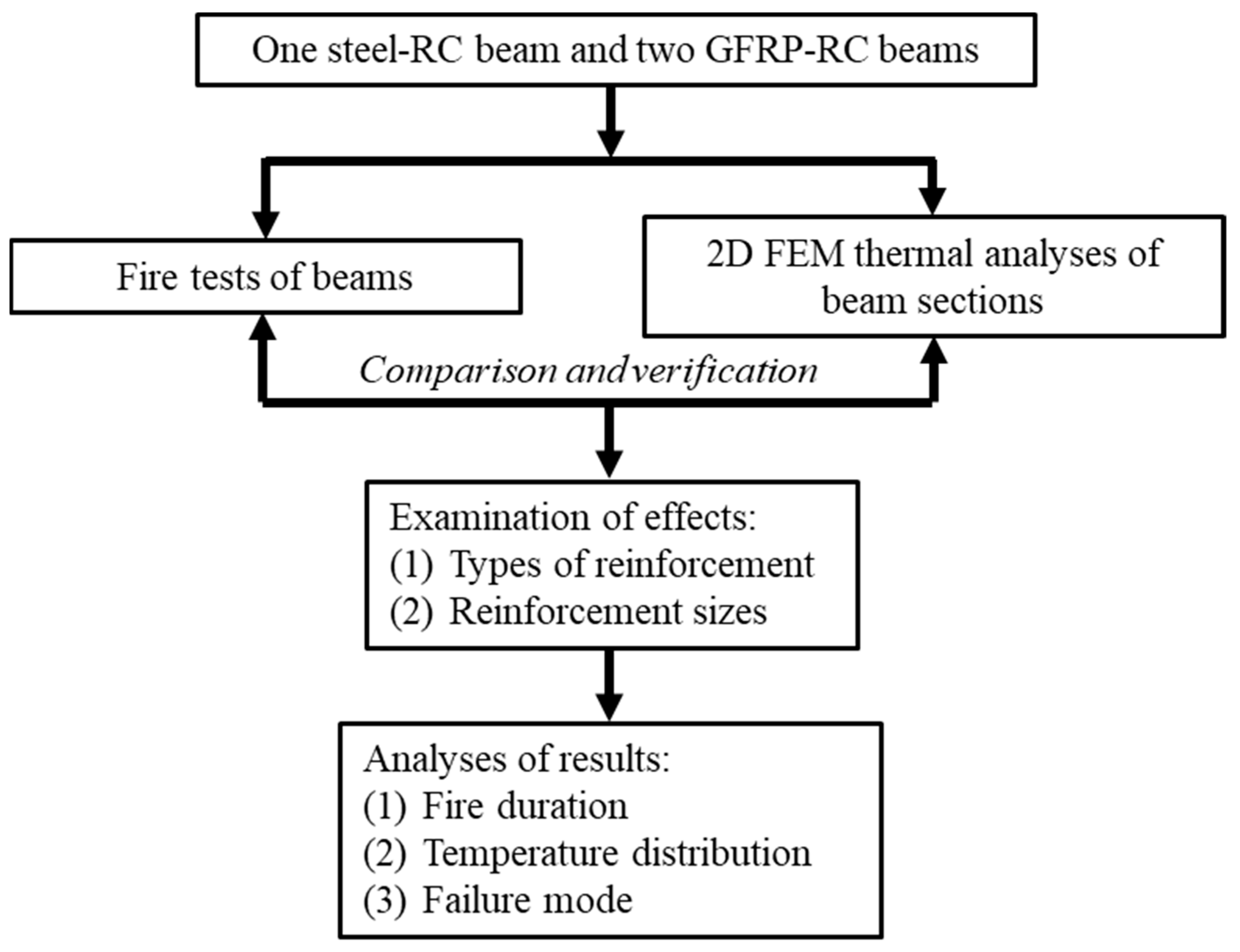
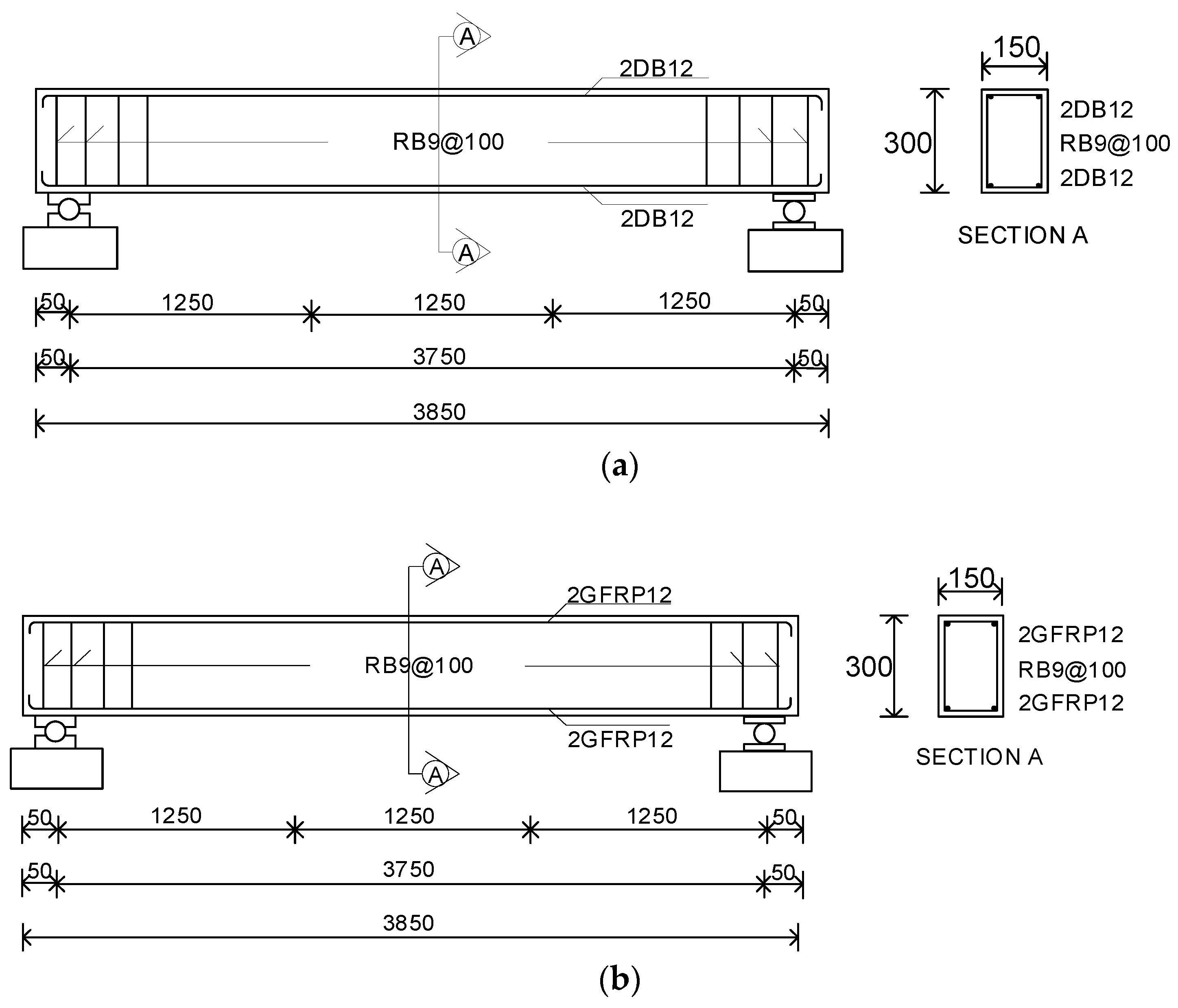
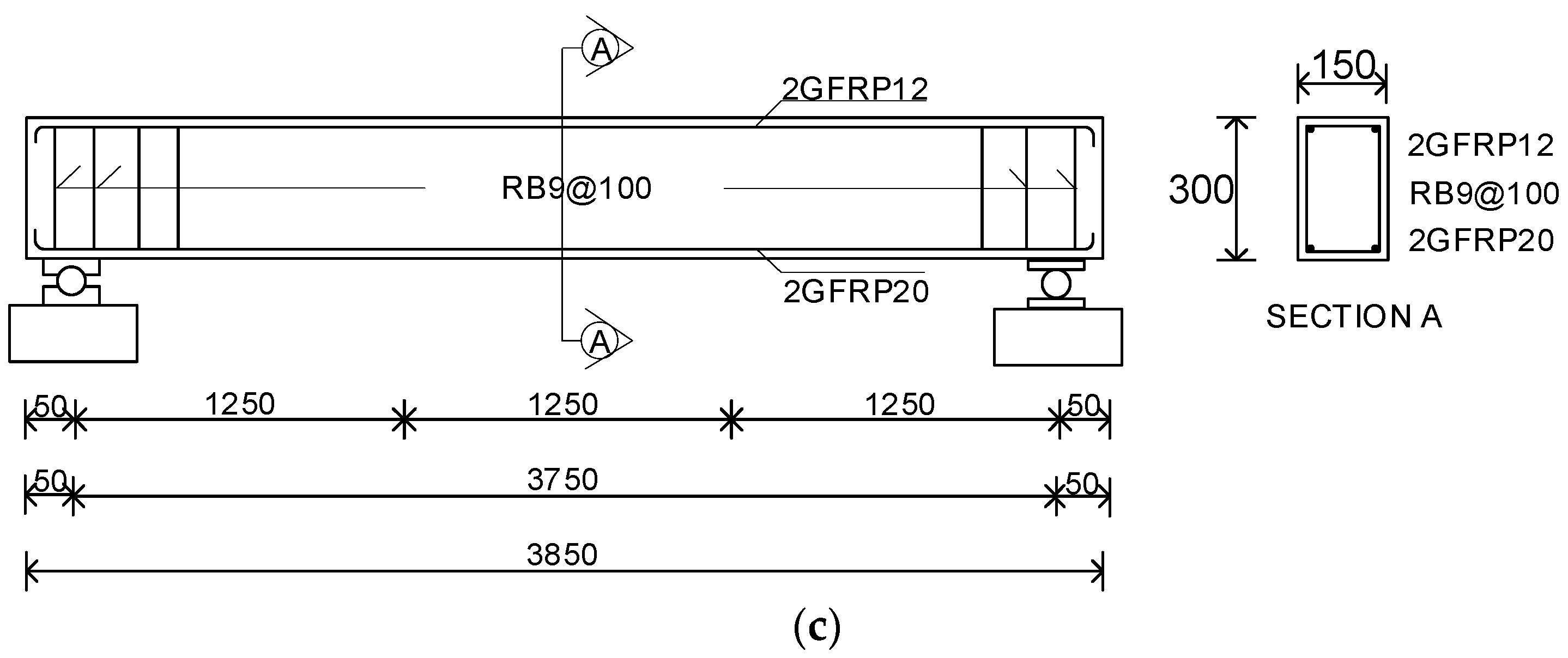



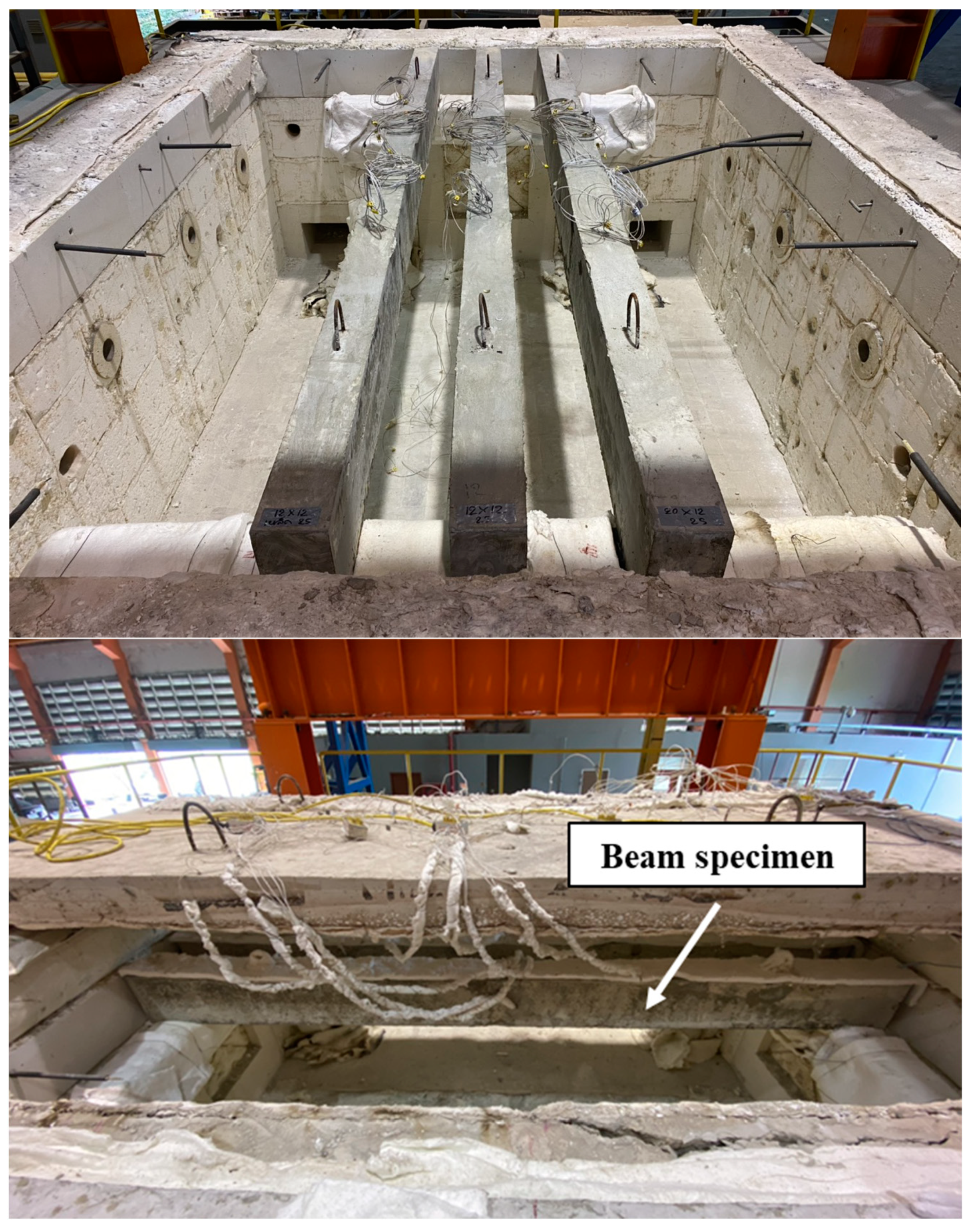
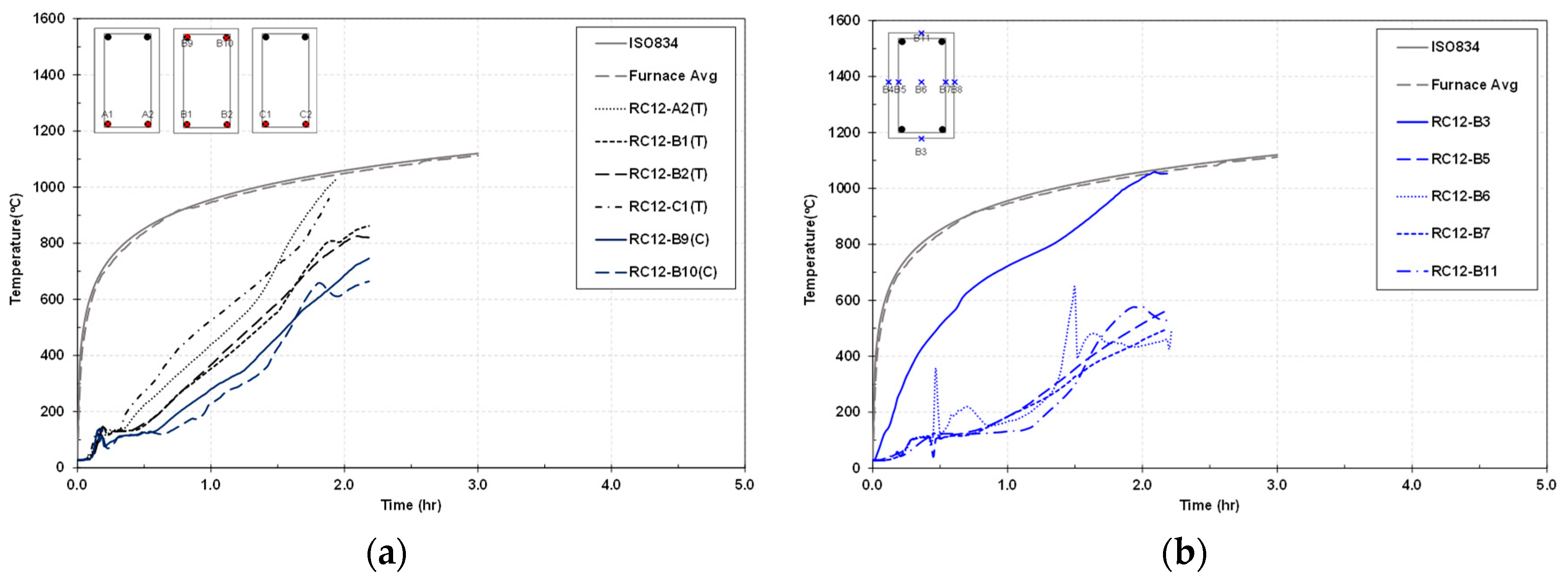
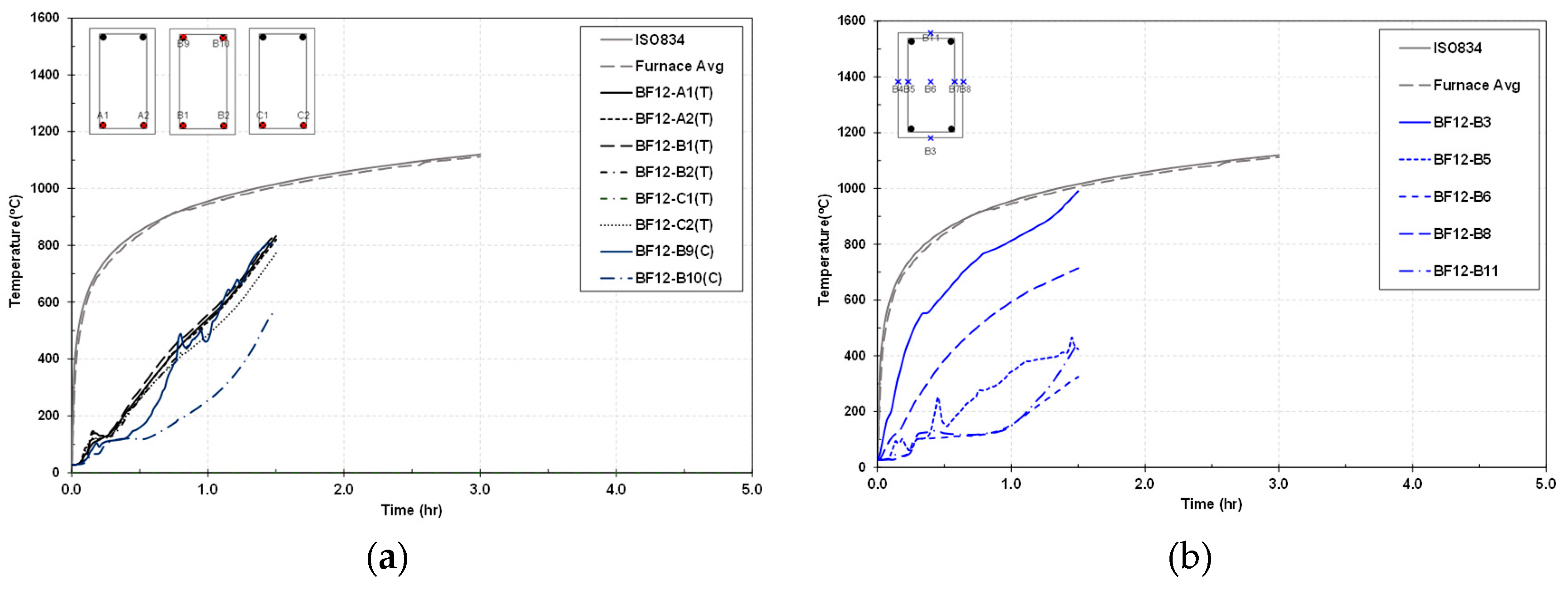
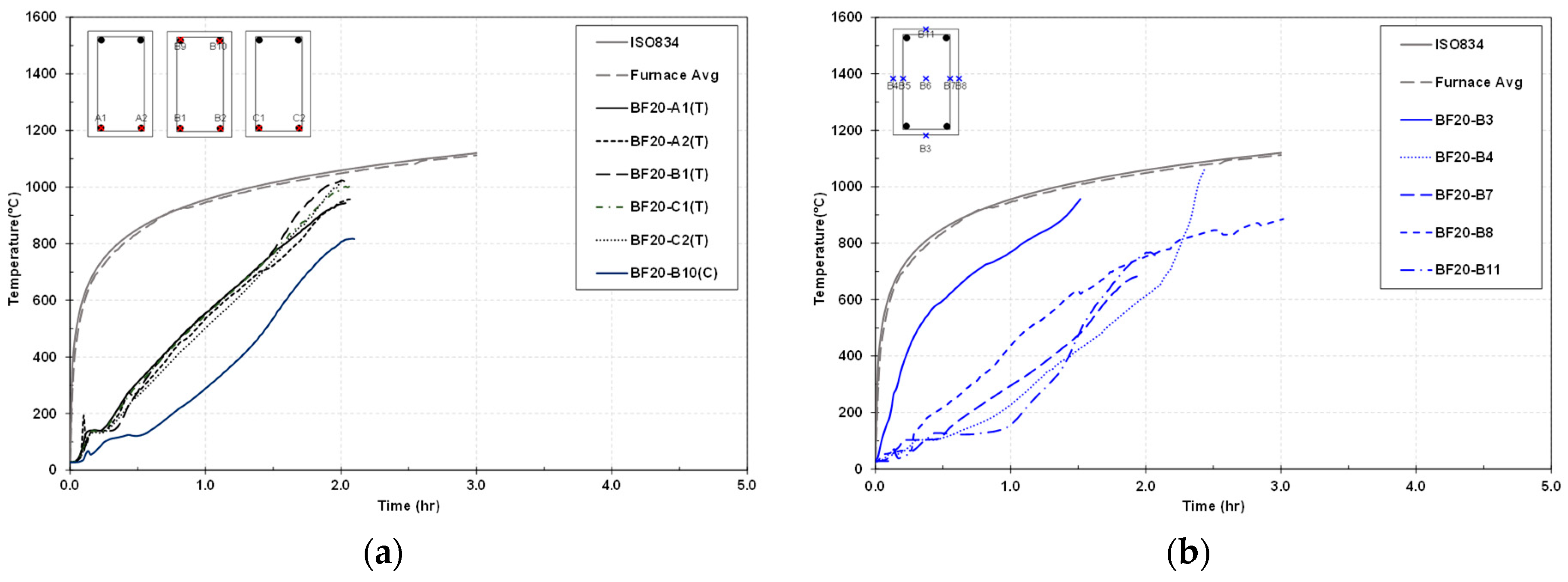

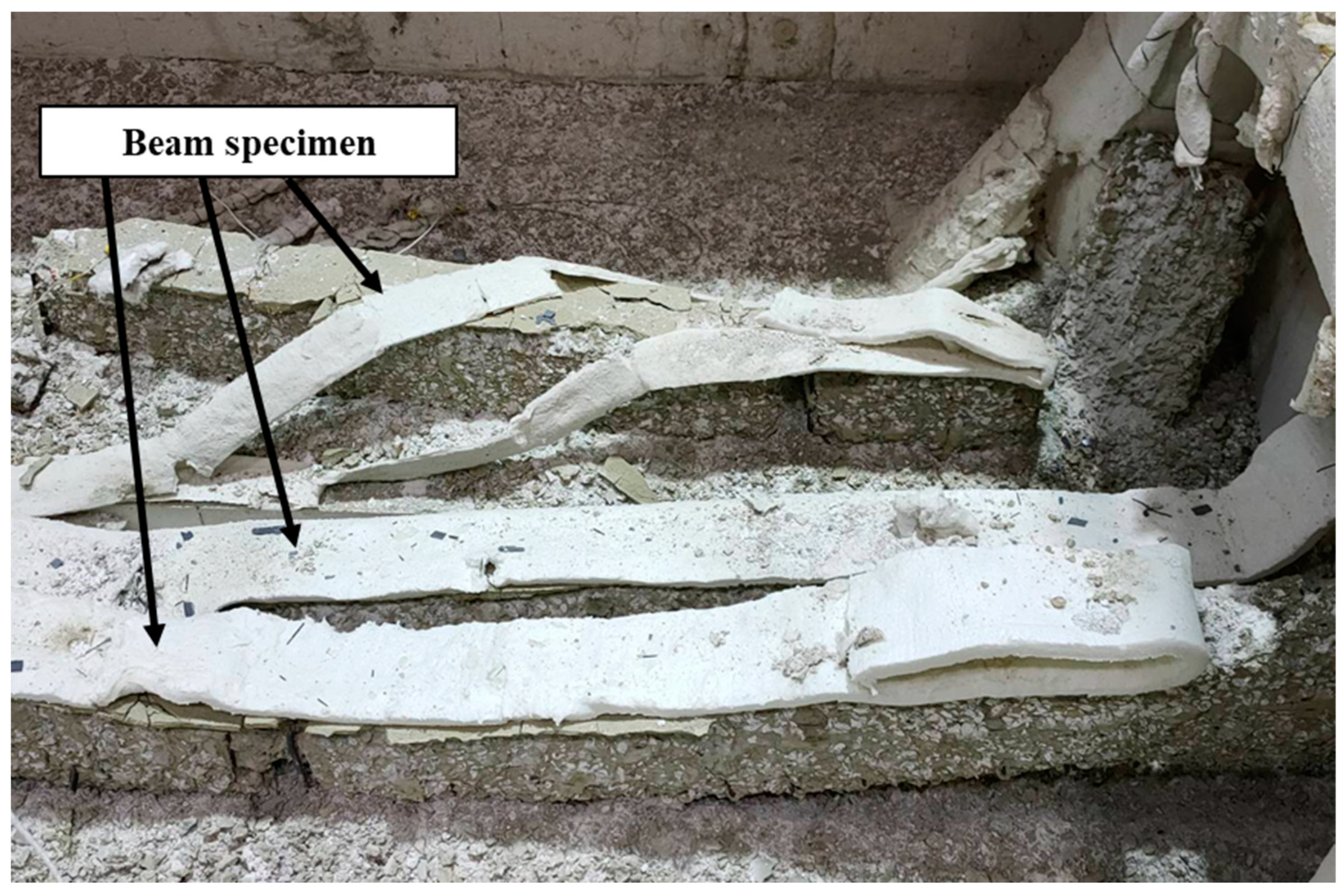
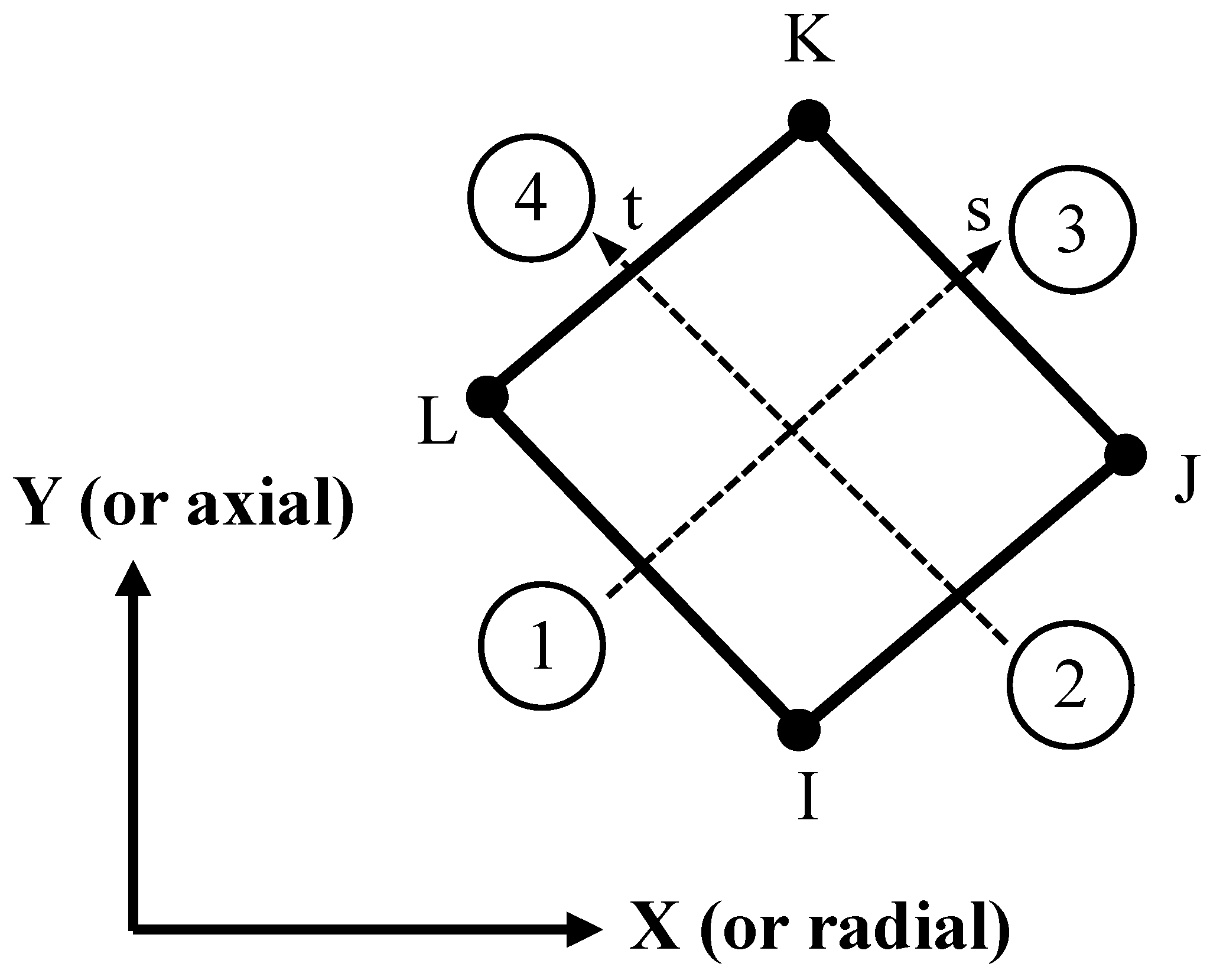
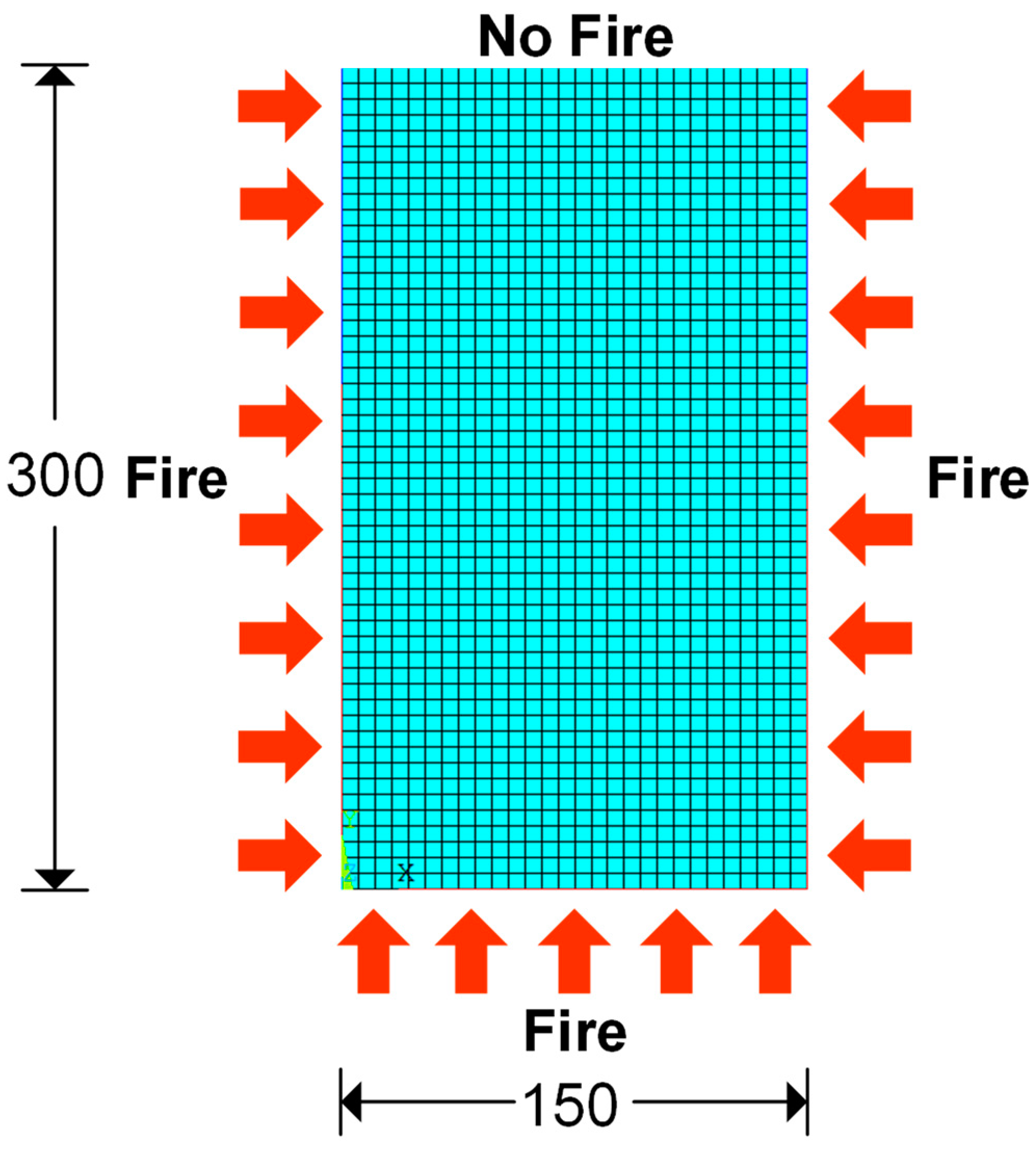
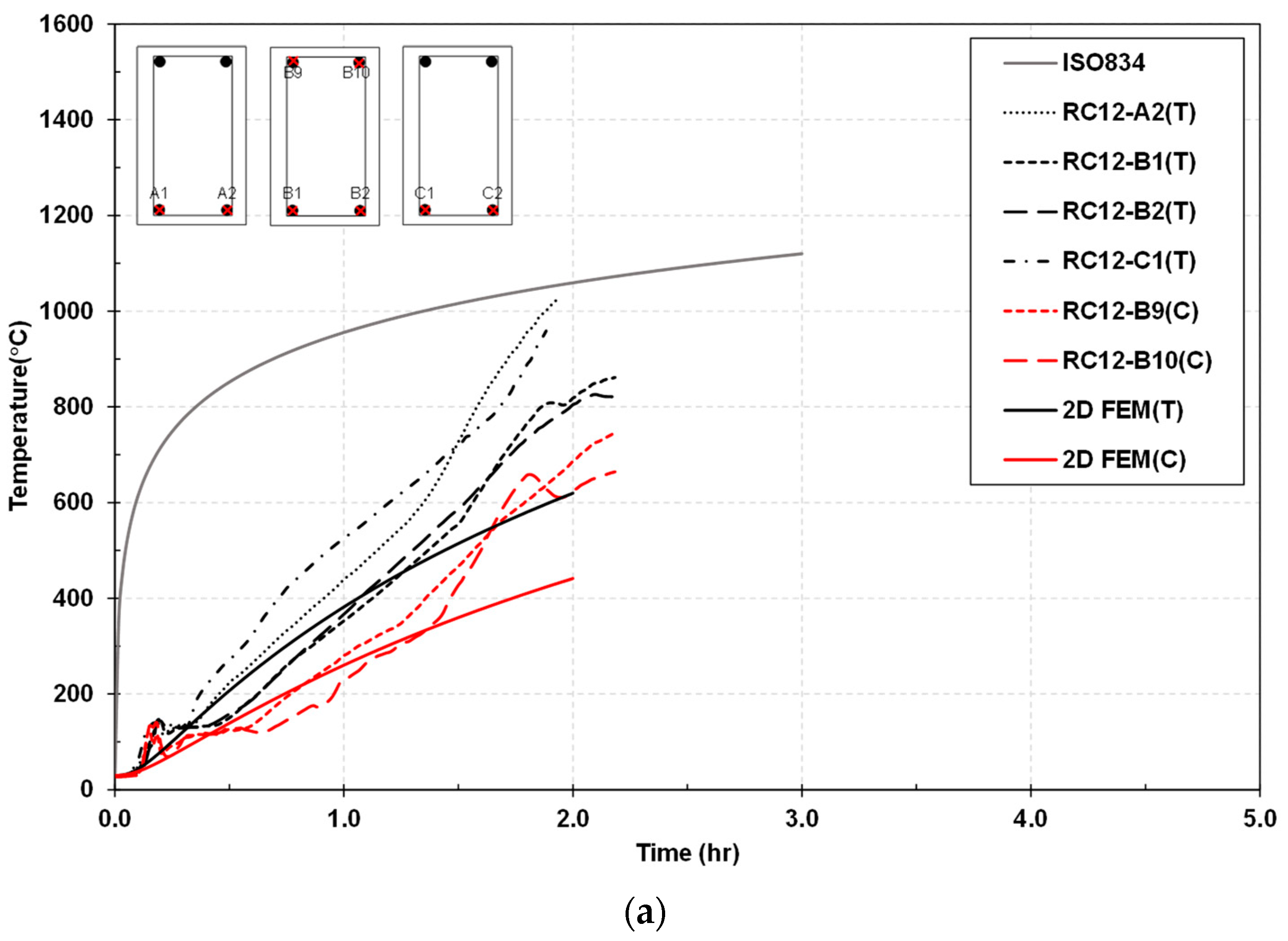
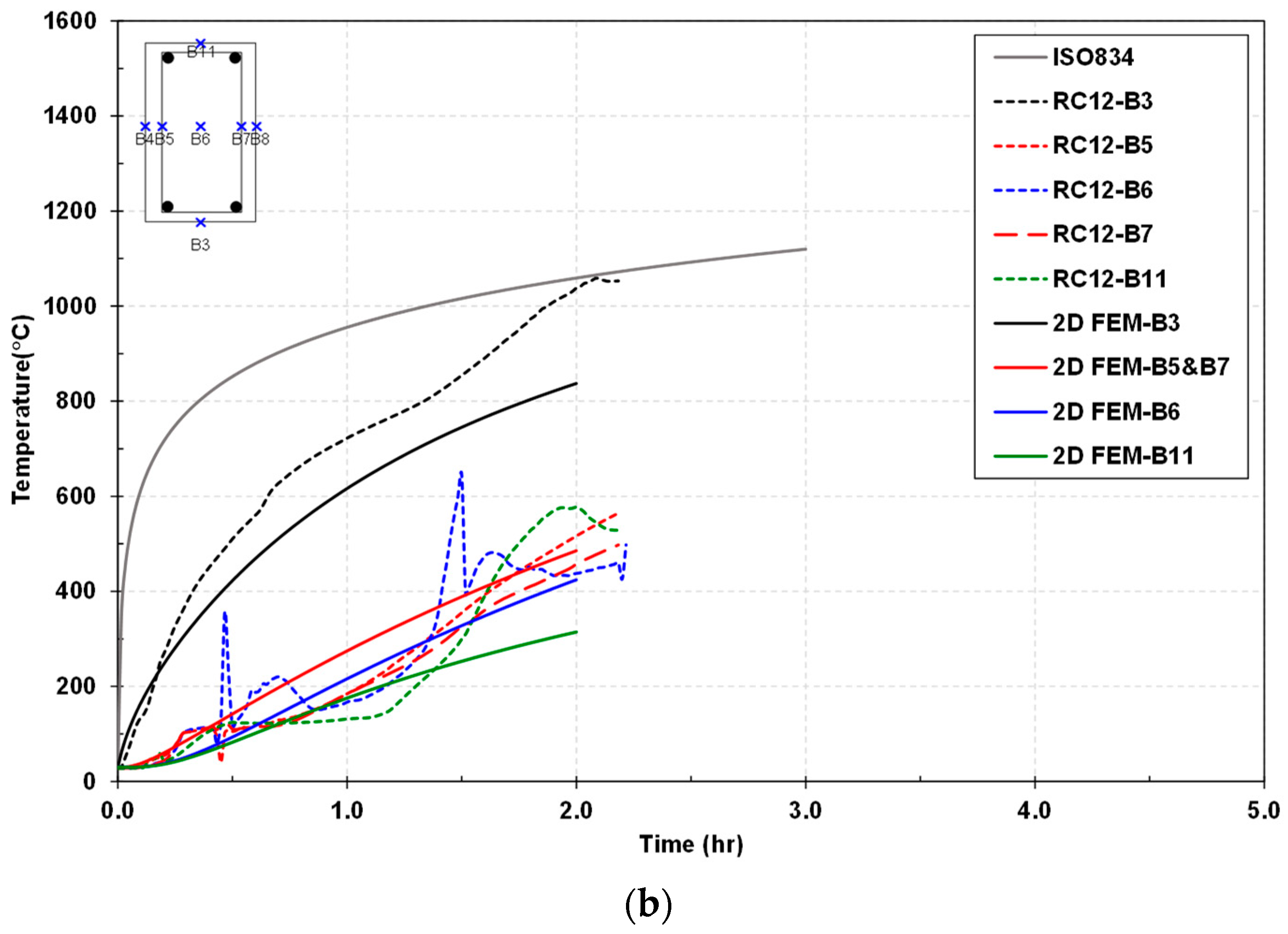
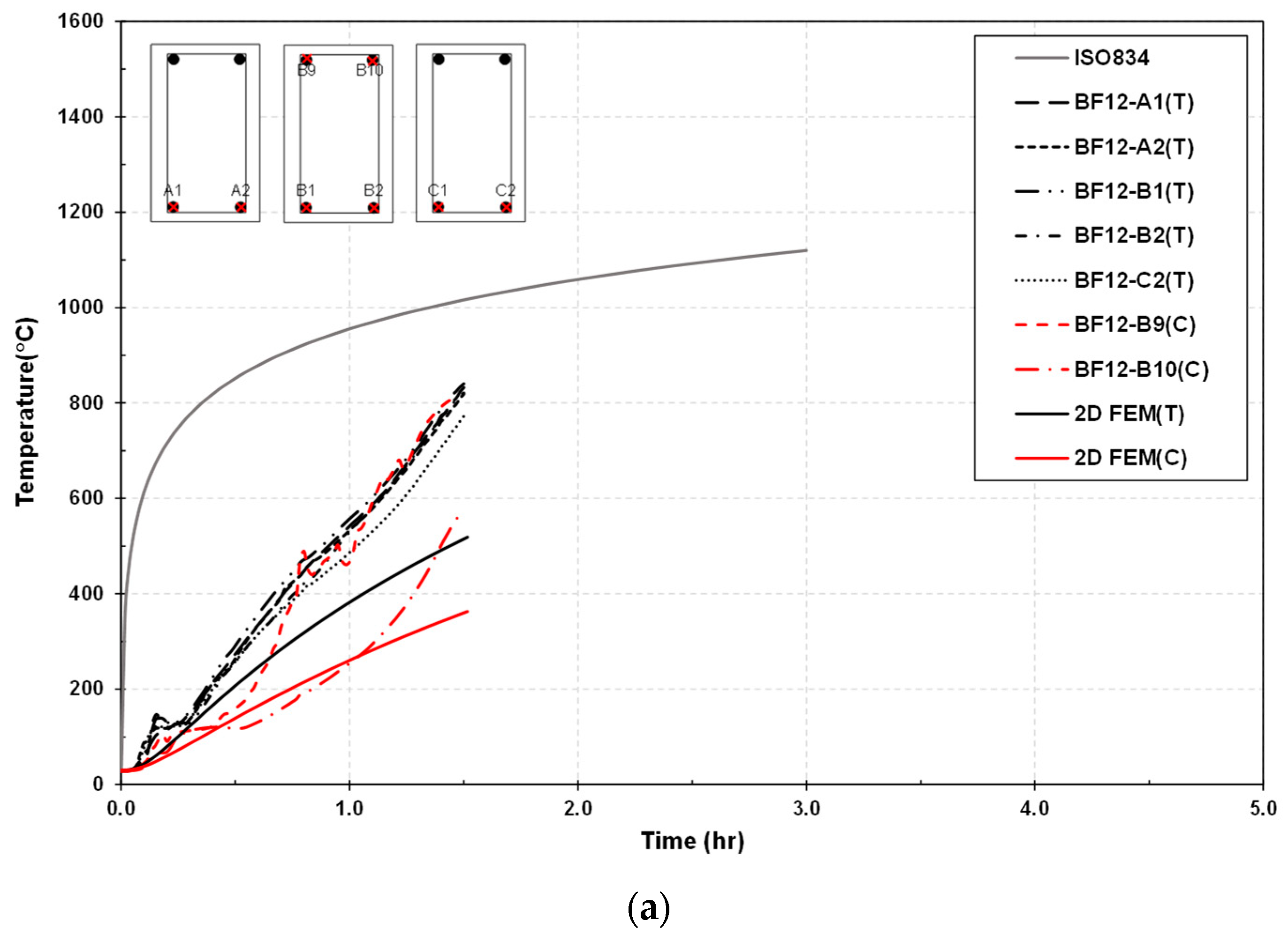
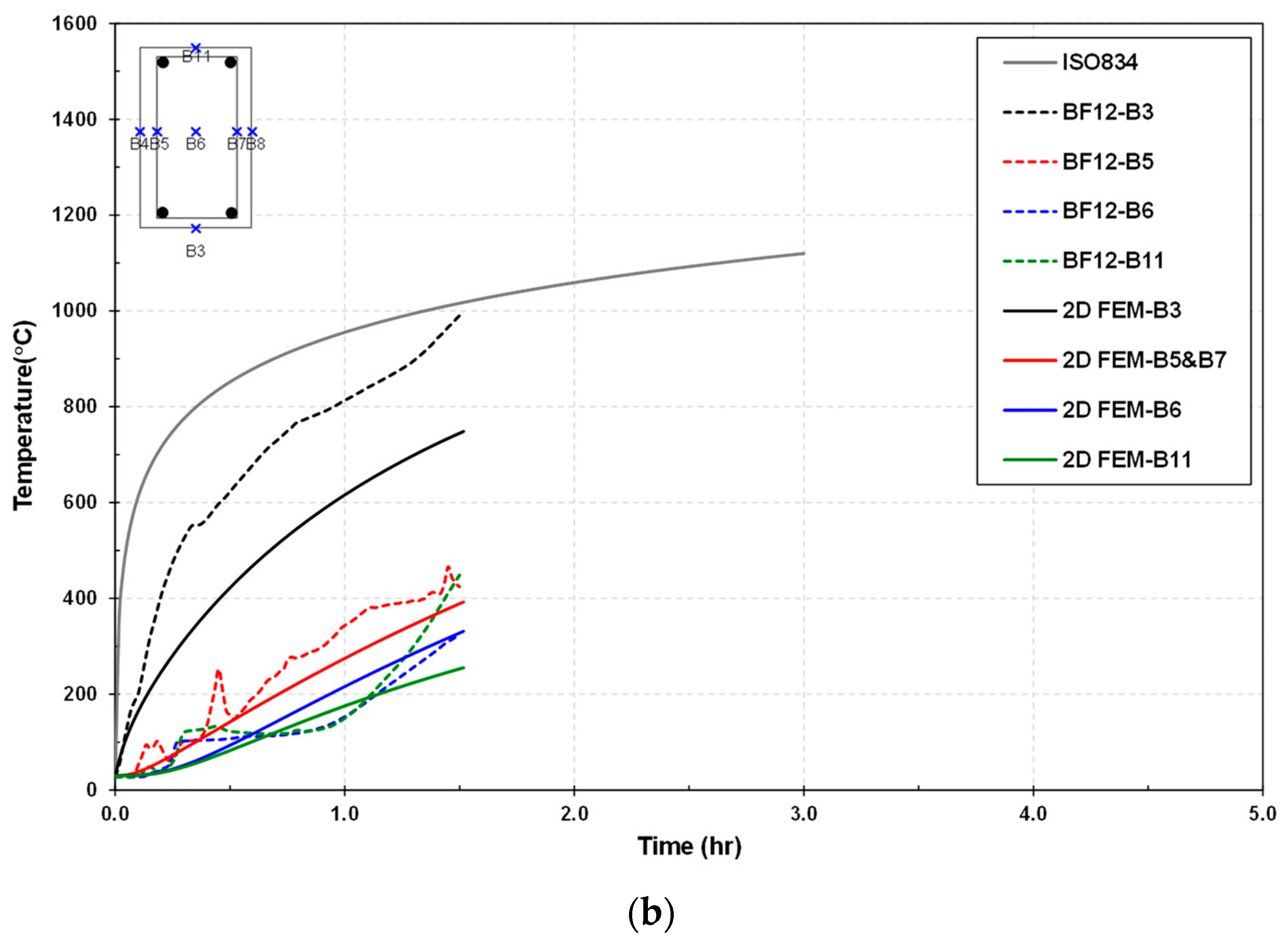
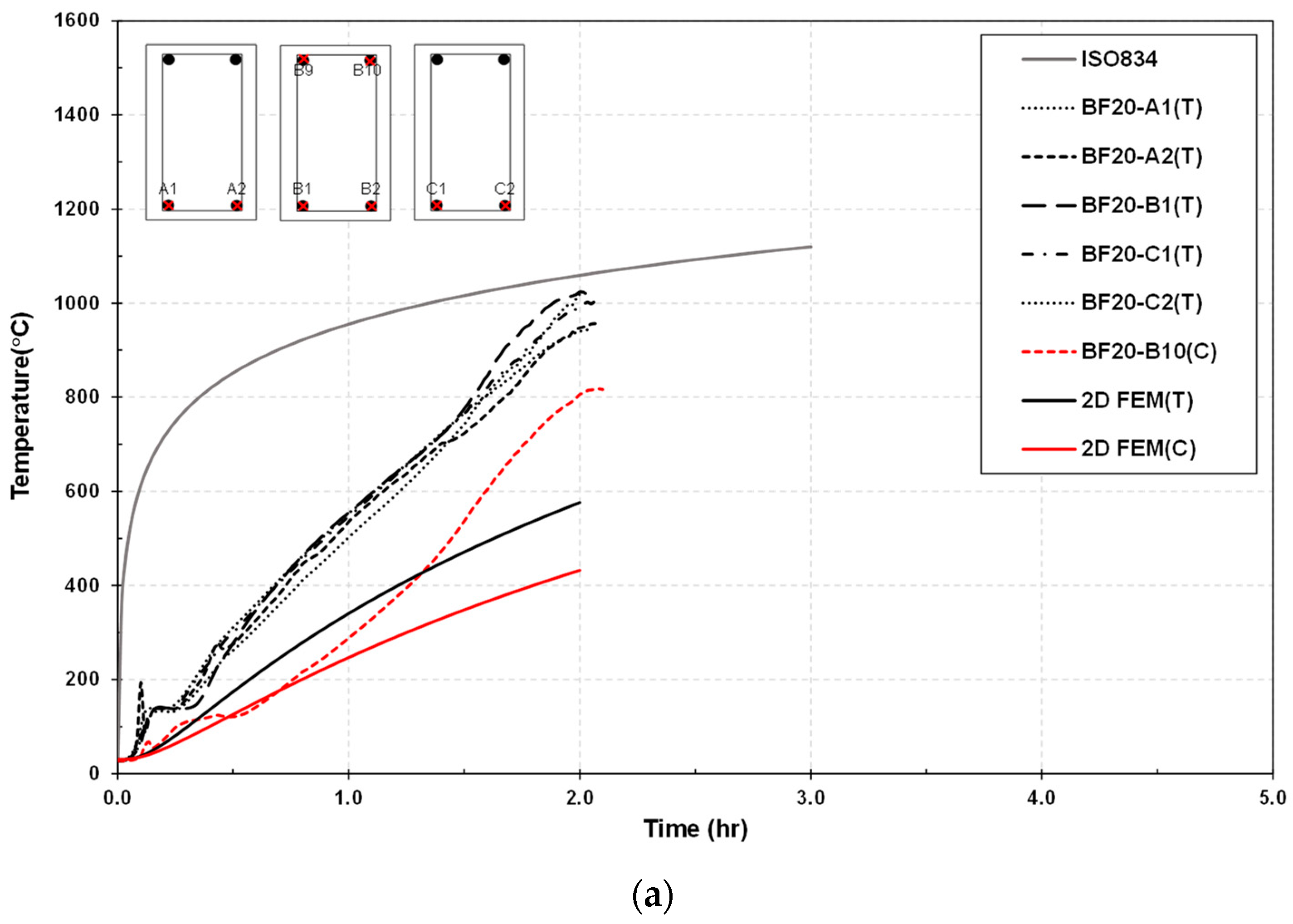
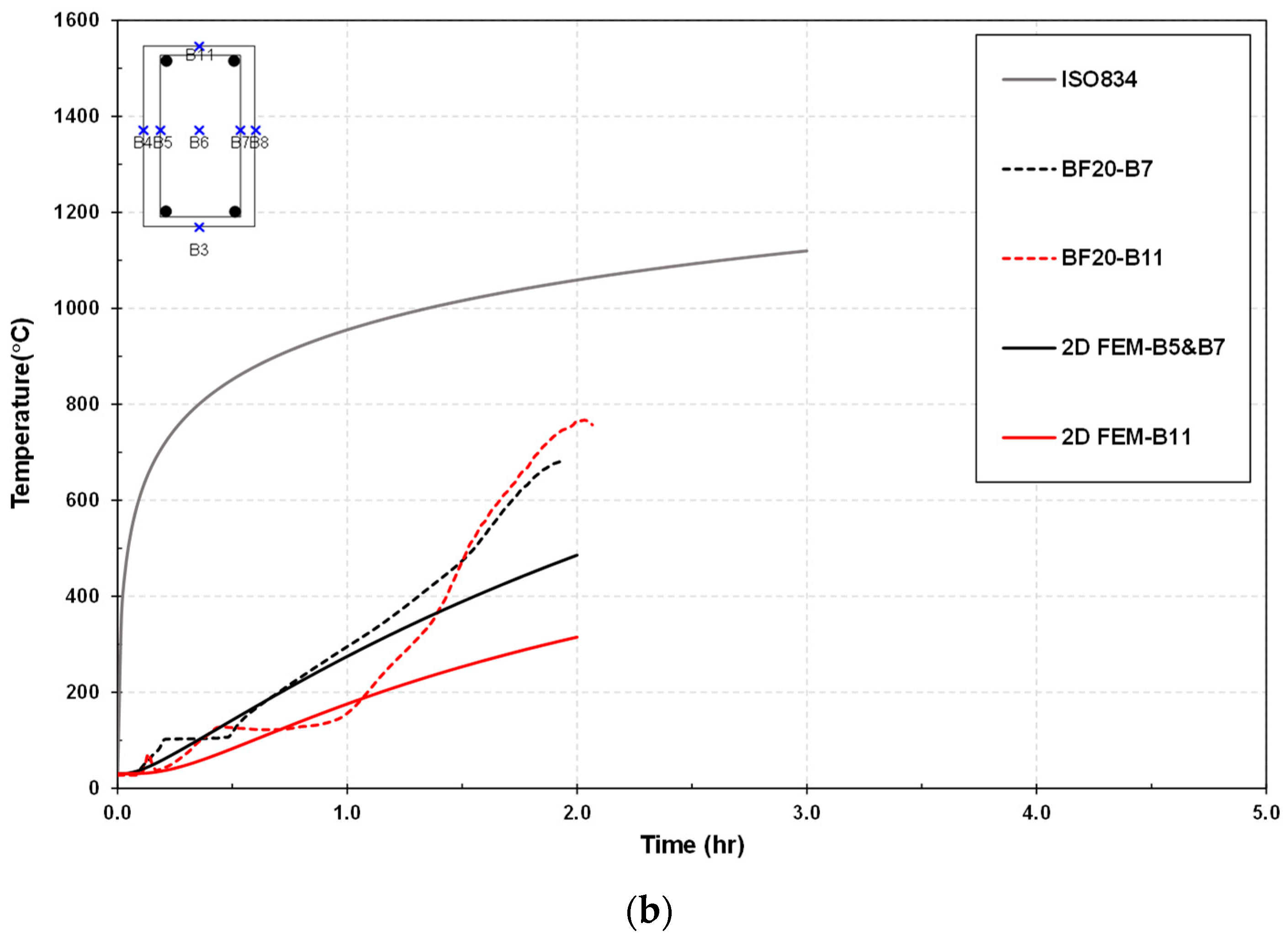
| Beam No. | Tension Reinforcement | Compressive Reinforcement |
|---|---|---|
| RC12 | 2DB12 | 2DB12 |
| BF12 | 2GFRP12 | 2GFRP12 |
| BF20 | 2GFRP20 | 2GFRP12 |
| Materials | Yield Strength (MPa) | Ultimate Strength (MPa) | Elastic Modulus (GPa) |
|---|---|---|---|
| DB12 | 466 | 540 | 210 |
| RB9 | 270 | 410 | 206 |
| GFRP12 | - | 851 | 45 |
| GFRP20 | - | 935 | 45 |
| Steel Type | Chemical Composition % (Max) | ||||
|---|---|---|---|---|---|
| Carbon | Manganese | Phosphorus | Sulphur | Carbon+ Manganese/6 | |
| RB9 | 0.28 | - | 0.060 | 0.060 | - |
| DB20 | - | 1.85 | 0.060 | 0.060 | 0.500 |
| TC Position | RC12 (minutes) (Tcr = 593 °C) | BF12 (minutes) (Tcr = 300–330 °C) | BF20 (minutes) (Tcr = 300–330 °C) |
|---|---|---|---|
| A1 | - | 33–36 | 29–33 |
| A2 | 80 | 33–36 | 33–37 |
| B1 | 90 | 31–34 | 32–35 |
| B2 | 91 | 34–38 | - |
| C1 | 71 | - | 30–34 |
| C2 | - | 34–38 | 35–39 |
Disclaimer/Publisher’s Note: The statements, opinions and data contained in all publications are solely those of the individual author(s) and contributor(s) and not of MDPI and/or the editor(s). MDPI and/or the editor(s) disclaim responsibility for any injury to people or property resulting from any ideas, methods, instructions or products referred to in the content. |
© 2023 by the authors. Licensee MDPI, Basel, Switzerland. This article is an open access article distributed under the terms and conditions of the Creative Commons Attribution (CC BY) license (https://creativecommons.org/licenses/by/4.0/).
Share and Cite
Thongchom, C.; Bui, L.V.H.; Poonpan, N.; Phudtisarigorn, N.; Nguyen, P.T.; Keawsawasvong, S.; Mousa, S. Experimental and Numerical Investigation of Steel- and GFRP-Reinforced Concrete Beams Subject to Fire Exposure. Buildings 2023, 13, 609. https://doi.org/10.3390/buildings13030609
Thongchom C, Bui LVH, Poonpan N, Phudtisarigorn N, Nguyen PT, Keawsawasvong S, Mousa S. Experimental and Numerical Investigation of Steel- and GFRP-Reinforced Concrete Beams Subject to Fire Exposure. Buildings. 2023; 13(3):609. https://doi.org/10.3390/buildings13030609
Chicago/Turabian StyleThongchom, Chanachai, Linh Van Hong Bui, Natthanuch Poonpan, Natcha Phudtisarigorn, Phuoc Trong Nguyen, Suraparb Keawsawasvong, and Saeed Mousa. 2023. "Experimental and Numerical Investigation of Steel- and GFRP-Reinforced Concrete Beams Subject to Fire Exposure" Buildings 13, no. 3: 609. https://doi.org/10.3390/buildings13030609
APA StyleThongchom, C., Bui, L. V. H., Poonpan, N., Phudtisarigorn, N., Nguyen, P. T., Keawsawasvong, S., & Mousa, S. (2023). Experimental and Numerical Investigation of Steel- and GFRP-Reinforced Concrete Beams Subject to Fire Exposure. Buildings, 13(3), 609. https://doi.org/10.3390/buildings13030609







